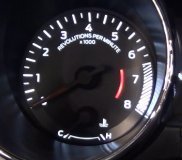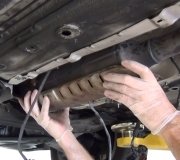The car starts up fine. When the engine temperature is cold (coolant temperature gage is below "C"), it idles higher than when the engine is at normal operating temperature (anywhere between 190 and 210 degrees F). When the engine temperature is cold, the engine can be revved in neutral (by stabbing the accelerator), and you have the expected snap increase in engine rpms. As the engine is warming up, stabbing the accelerator results in the engine hesitating / stumbling before the engine rpms increase. As long as the revs are above idle, the accelerator can be stabbed, and the engine rpms immediately increase. If, however, the engine rpm is allowed to return to idle, the next stab of the accelerator results in the aforementioned hesitation / stumble before the rpms start to increase. This hesitation / stumble gets gradually worse as the engine approaches normal operating temperature. All of the above events take place when the car is in neutral (park).
If the car is driven when the engine is at normal operating temperature, the car will accelerate smoothly if you press the accelerator about 1/4 of the way down. Pressing the accelerator down further than this will cause the engine to start to periodically stumble. The further down your press the accelerator, the worse the stumbling becomes. If the accelerator is floored, the engine has trouble maintaining the vehicle's rate of progress from before you stepped on the accelerator, and it never gets better / remains stuck in a violent bout of hesitation (no matter how long you keep your foot on the floor. I kept it down for about 1/8 of a mile with absolutely no change). If the car starts to pull a hill on the interstate, the stumbling prevents the vehicle from accelerating up the hill. And, if the hill is sufficiently steep, the engine will not be able to maintain the vehicle's speed. You never get any black smoke out of the exhaust during engine operation, which makes me think (OK, guess) that the engine may be running lean when it stumbles.
I have worked on several different versions of GM's 60-degree V6 over the years, and (over two months ago) figured I could easily determine the cause of the hesitation. Things I have done to the motor so far (in roughly the order I did them):
- Upper and lower intake manifold gasket replacement with the new upgraded FelPro metal gasket set (I was going to do this anyway, as my aunt's car was showing the classic leaking intake manifold sign of oil in the coolant);
- Removal and cleaning of the throttle body and all associated sensors (anti-stall sensor (?) Up top, and the throttle position sensor on the bottom);
- Replacement of the cam shaft position sensor (noticed one of the wires on the top of the sensor was broken while preforming the intake manifold gasket replacement);
- New spark plugs (my aunt had the local dealer do that, not me. And she paid almost $15 per AC Delco plug when I could have gone to Autozone and purchased them for $6. Grrrrrr, she doesn't have that kind of money to spend!);
- Swapped out spark plug wires (have many extra plug wires lying around the garage, and swapped many of the wires on my aunt's car out while diagnosing a bad ignition coil pack. Also replaced said coil pack with one of my many junk-yard coil packs lying around the garage);
- Visually inspected all wires leading to and from the ignition control module (on which the coil packs sit) for signs of missing loom, wire pinching or chafing. Nothing appeared out of the ordinary;
- Beat on the top of the engine management computer while increasing engine revs to see if the hesitation changed (it didn't);
- Beat on the throttle position sensor while increasing engine revs to see if the hesitation changed (it didn't);
- Tested for good vacuum at the intake manifold and the vacuum reserve canister (vacuum was within spec at idle, and would briefly fall to zero when you stabbed the accelerator before recovering);
- Tested for properly functioning fuel pressure regulator (fuel pressure jumped up about 12-15 psi when the vacuum line was removed from the regulator. I did this about two months ago with a seemingly good functioning fuel pressure tester, and not with the tester mentioned in the next bullet point);
- Tested for proper fuel rail pressure (this was a bit of a challenge, because the Autozone lend-a-tool fuel pressure tester didn't seem to be operating quire right. The last borrower had ripped the needle and needle gasket out of the fitting that screws into the fuel rail. I was able to create a new gasket with some vacuum hose, and reseated the needle, but fuel pressure seemed to rise slowly in the gauge. Ultimately, the fuel pressure rose to the lower end of the acceptable operating range, about low 30's psi);
- Replaced the fuel filter (I think this was unnecessary, as the old filter wasn't very heavy);
- Replaced the fuel pump / pump screen / fuel tank emission hoses (second guessed myself because of the issues with the fuel pressure gauge. Just finished this project this afternoon, and it had absolutely no effect on engine performance. Aaargh!)
I don't like throwing parts at a problem. I have done my best to verify voltages and pressures before purchasing replacement parts. I have now checked everything I can think of, except for the up-stream O2 sensor (this being OBD1-ish, I don't think it has a downstream sensor). I just spend $100 on the fuel pump and strainer, and it didn't fix the problem. This makes me angry (with myself for not being more patient). I don't want to purchase an O2 sensor for another $75 / $100 if it won't fix the problem.
As far a diagnostic tools are concerned, I have a vacuum gauge and a voltmeter. I can borrow the fuel pressure gauge if need be. I do not have access to an ocilliscope.
Can you please suggest anything else I may need to check (and how to check it) before I purchase the O2 sensor? Thank you in advance for your assistance.
Eric
Saturday, December 28th, 2013 AT 2:12 PM


